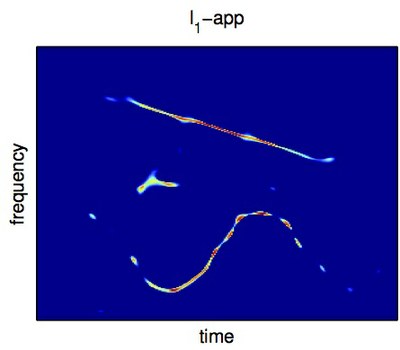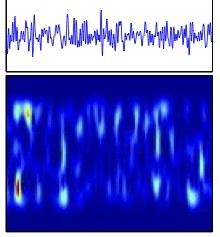Traitement du signal non-stationnaire
Nonstationary signal processing
 Time-frequency methods
Time-frequency methods
Fundamentals in time-frequency have been followed in the recent years in two directions: 1) Construction of sparse energy distributions from a “compressed sensing” approach. 2) Exploitation of phase information in Short-Time Fourier Transforms, with new phase-magnitude relationships, an improved reassignment scheme and new results on (reassigned) spectrogram geometry. This has also been explored within the framework of "synchrosqueezing”, with comparisons to both EMD (see infra) and reassignment.
 DATA-Driven decompositions
DATA-Driven decompositions
Besides point-wise practical issues (e.g., sampling), the data-driven technique of Empirical Mode Decomposition (EMD) has been investigated in many different directions:
1) Model-free disentanglement of nonstationary signals into a trend and a fluctuation. 2) Gap-filling in data with missing samples.
3) Limitation of “mode mixing” effects in a noise-assisted way, thanks to an improvement upon conventional Ensemble EMD that presents the two-fold advantage of increasing coherence of the averaging while guaranteeing a perfect reconstruction.
4) Reformulation in analogy with the “texture-geometry” decomposition problem in image analysis, taking advantage of recent advances in optimization and proximal methods: a new framework has been proposed, that gets rid of the loosely controlled “sifting” process that is involved in classical EMD, and replaces it by an optimization problem with constraints reflecting what EMD modes are supposed to be. This proved effective for signals and led to natural extensions to images.
 Characterizing and Analyzing NONSTATIONARITIES
Characterizing and Analyzing NONSTATIONARITIES
Most recent efforts have been devoted (within ANR StaRAC) to revisiting the concept of stationarity from an operational perspective. This includes the following contributions:
1) It has first been argued that stationarity should only been considered in a relative sense, including an observation scale in the definition as well as in the analysis.
2) It has been shown that any signal, stationary or not, can be transformed in a “surrogate” stationary signal via a proper randomization of its phase spectrum.
3) A general methodology has been settled for testing stationarity on the basis of such surrogates used as elements of reference for the null hypothesis of stationarity. In the specific case of a non homogeneous process, an alternative stationarity test has been proposed by searching for an optimal partition thanks to a network flow algorithm.
4) Surrogates have been given a “machine learning” interpretation, leading to testing procedures as well as characterizations of different types of nonstationarities.
Other recent contributions include and alternative definition of instantaneous frequency, multitapering in cepstral analysis, and an entropy-based method for counting components.



